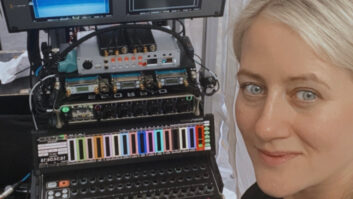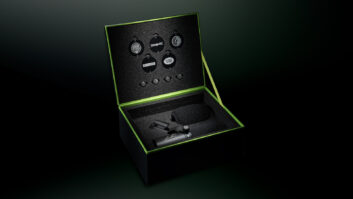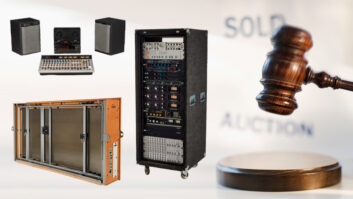
More and more projects are moving to completely in-the-box production and post-production. With such a workflow and some judicious choices, you can outfit a well-rounded project studio for $35,000 or less.
For the following studio configuration, we assume you already have a fairly powerful Mac or Windows computer with a free Ethernet connection and Thunderbolt port. All the plug-ins listed are Mac/Windows AAX Native-compatible to go along with the chosen Pro Tools DAW. Prices listed are MSRPs.
DAW/Control Surfaces
Despite the record number of great DAWs in the world, many of which enjoy booming user bases, Pro Tools still has the lockdown on professional industry-standard status, so that’s where we begin. You can add extra, usually lower-priced DAWs, as you see fit.
This is the year that we embrace subscription plans, and Avid Pro Tools 12 ($599) has different options available. However, the purchase price in this case fits nicely into the budget, and we’ll pair it with the powerful, small-format Avid Pro Tools | S3 ($4,999) Eucon-enabled controller, mixer and 4×6 high-res AVB (Ethernet) audio interface with 16 motorized controllers, channel displays and 32 touch-sensitive, pushbutton encoders. This gives you complete ability to create and record tracks, write automation, launch plug-ins, manage routing, etc. Add in the Avid Artist Transport($444) jog wheel/shuttle ring/numeric key/transport controller, and barely touch your keyboard and mouse in the studio.

Avid Pro Tools | S3
But that’s not the end of the Pro Tools-specific control. For years, the iPad has been the multitouch controller of music producers’ dreams, and last year, we got the gift of an even bigger iPad screen for musical applications. The 12-inch Apple iPad Pro 128GB with Smart Keyboard ($1,118 total) gives you an ample and beautiful display for Avid’s free Pro Tools | Control app. When paired with the S3 and Artist Transport, Pro Tools | Control uses the same Eucon technology over Pro Tools and other DAWs, to help you create smooth and custom workflows.
Finally, a couple of high-class MIDI controllers round out this section. The tank-like Arturia KeyLab 88 ($999) combines a Fatar-designed 88-key hammer action keyboard with velocity sensitivity and aftertouch with Analog Lab software—including 5,000-plus presets from the Arturia V Collection of vintage-inspired soft synths. Its complement of knobs, faders and pads are pre-mapped to the synth presets.
A huge innovation to the venerable MPC line, the Akai MPC Touch ($799) adds a multitouch color display to a completely re-envisioned controller to make the piece eminently more capable while keeping it compact. The included MPC software provides a deep beat-making environment that runs stand-alone or as an AAX/AU/VST plug-in. MPC software even hosts VSTs, so you could use it as a back door for bringing VSTs into Pro Tools. A USB audio interface makes this an excellent portable studio along with a laptop, and it fits on top of the KeyLab 88’s empty surface when you’re not traveling.

Akai MPC Touch
DAW/control surfaces sub-total: $8,958
Monitoring
We’ll use the S3’s monitoring outputs for a couple pairs of TEC Award-nominated monitors. The mains will be the super-accurate Barefoot Sound MM45 MicroMain45 ($5,995/pair) 3-way, 8-inch aluminum woofer active monitors, which offer the same sound quality of the larger MiniMain 12s but for a much smaller price.

Barefoot Sound MM45 MicroMain45
We chose the JBL LSR305 5-inch Active Studio Monitors ($399/pair) as the small-format near-field reference speakers. They’re designed for accuracy and a great stereo image at lower volume levels.
For headphone mixing and mastering, the Audio-Technica ATH-R70x ($489) professional open-back reference headphones issue a flat response across its full range of 5Hz-40kHz. Proprietary 45mm neodymium drivers also help deliver accurate frequency balance.
Monitoring sub-total: $6,883
Mics & Recording
In the mic department, we want something special yet not too taxing on the budget. A matched pair of Audio-Technica AT5045 ($2,499/pair) large-diaphragm condenser microphones fits the bill. Their side-address design, 149dB SPL handling and remarkable, smooth detail make them a fitting choice for many recording situations and tight spaces, whether used in a single-mic or stereo dual-mic situation.

Audio-Technica AT5045
To take care of the all-around workhorse mics, we’ll procure one each of the Shure Beta 58A ($199), Beta 57A ($174) and SM7B ($436), which all told give you something for every singing, voiceover and instrument recording situation.
Finally, we treat ourselves to an especially fine ribbon microphone—the highly acclaimed Royer R-122 MKII ($1,995) active ribbon mic—to enjoy the advantages of its sensitive aluminum ribbon’s high-frequency detail while being able to record high-SPL sources with the same high output as a condenser mic.
For field recording and other mobile recording situations, the Zoom H6 Handy Recorder ($499) 6-in/2-out recorder and USB audio interface strikes the right balance between professional quality and features with price. It includes XY and mid-side mic attachments, and we’ll add the SGH-6 Shotgun Mic Capsule($129) for targeted distant sound pickup in the field.

Zoom H6 Handy Recorder
Every in-the-box studio should have massive storage, so we’ll grace this one with the G-Technology G-RAID 12TB ($999) Thunderbolt/USB 3 hard drive. This has two discrete, removable 6TB disks with a variety of configurations to emphasize either speed or data security. With USB 3 and two Thunderbolt connections, it can drop into any studio and let you daisy-chain Thunderbolt devices.
Mics & recording sub-total: $6,930
Analog Hardware
We shudder to think of completely abandoning the magic touch of analog signal paths in a studio, so a couple of key pieces will allow us to inject some natural warmth into any track. Let’s begin with Korg’s reissue of a more compact ARP Odyssey ($1,400). This duophonic reimagining of a classic analog synthesizer has USB, MIDI I/O and CV, Gate and Trig I/O connections, as well as a crucial audio input for routing sounds through the redesigned tri-filter section.
For a real, 2-channel analog powerhouse packed into an API Lunchbox, the Daking 500RS Recording System ($5,470) gives you a big analog console-style 2-channel recording chain with two Mic Pre 500 preamps, two Comp 500 compressors and two EQ 500 4-band equalizers with sweepable mids. Use it at your studio, a colleague’s or take it to a gig.

Daking 500RS Recording System
Analog hardware sub-total: $6,870
Synths, Processors and Soundware
If you’re starting from scratch and want access to an enormous selection of professional-grade, production-ready sounds for composition, a subscription to EastWest ComposerCloud Plus ($699/year) will suss you out immediately with 51 EastWest titles and more than 1TB of sounds. The collection skews heavily toward orchestra instruments and percussion, symphonic choirs and the like, but also includes massive drum collections, ethnic instruments, sound-design tools and wide-ranging instruments for different rock and electronic styles. The “Plus” subscription goes above and beyond the norm with extra instrument effects and the Diamond and Platinum editions of the composer libraries, which offer thousands of additional instruments utilizing selectable mic positions. This plan also includes a hard drive for storing all of the sounds and guarantees first access to new EastWest titles as they come out.
Let’s complement ComposerCloud with some of the baddest contemporary soft synths. Spectrasonics Omnisphere 2 ($499) rules the roost as one of the most diverse synths in the world. This second version blew the doors off another world of synthesis options, adding wavetable and granular synthesis, more than 400 new DSP waveforms, audio file import, new filters and effects, and more. Don’t forget the free iPad remote app, as well.

Spectrasonics Omnisphere 2
Two more synths will ensure you’re working with some of the most common tools in electronic music—which basically encompasses, pop, hip-hop and R&B, as well. Xfer Serum ($189) delivers stunning wavetable synthesis with excellent graphic editing and ability to easily import or create wavetables. And Lennar Digital Sylenth ($160) became a ubiquitous virtual analog plug-in for its excellent sound and an extremely powerful, yet accessible interface and fast, flexible patch-creation.
Pro Tools and McDSP plug-ins go together like whiskey and a good buzz. And because this is the year we learn to stop worrying and love the low upfront cost of an all-you-can-eat software subscription model, we’re going with the McDSP All-Access Native Subscription ($295/year or $29/month), all 20 of the company’s v6 dynamics, equalization, multiband mastering and special effects, including the acclaimed new FutzBox distortion/noise effect and SA-2 Dialog Processor. McDSP will throw all of its new products into the subscription package as they emerge.
We still need some guitar effects, so we’ll head to the trusted name of Softube and pick up both the Amp Room Bundle ($329) and Effect Bundle ($219). The former stacks all of Softube’s great amp simulators in one place: Vintage Amp Room, Metal Amp Room and Bass Amp Room. The Effect Bundle injects unique character with a Spring Reverb, Tube Delay and Acoustic Feedback for simulated amp feedback on any sound.
Post-production duties will fall largely to iZotope’s RX Post-Production Suite ($1,499), a square deal for the amazing and comprehensive RX 5 Advanced Audio Editor, RX Final Mix, RX Loudness Control and the Insight metering plug-in.
Synths, Processors and Soundware sub-total: $3,889
After all that, we’re still a little bit under budget, so the extra cash can go toward another year of software subscriptions and filling up that enviable iPad Pro with the greatest music apps you can find.
Grand total: $33,530
Click here to read how engineer/producer Wes Maebe would outfit his analog studio for $100,000.







